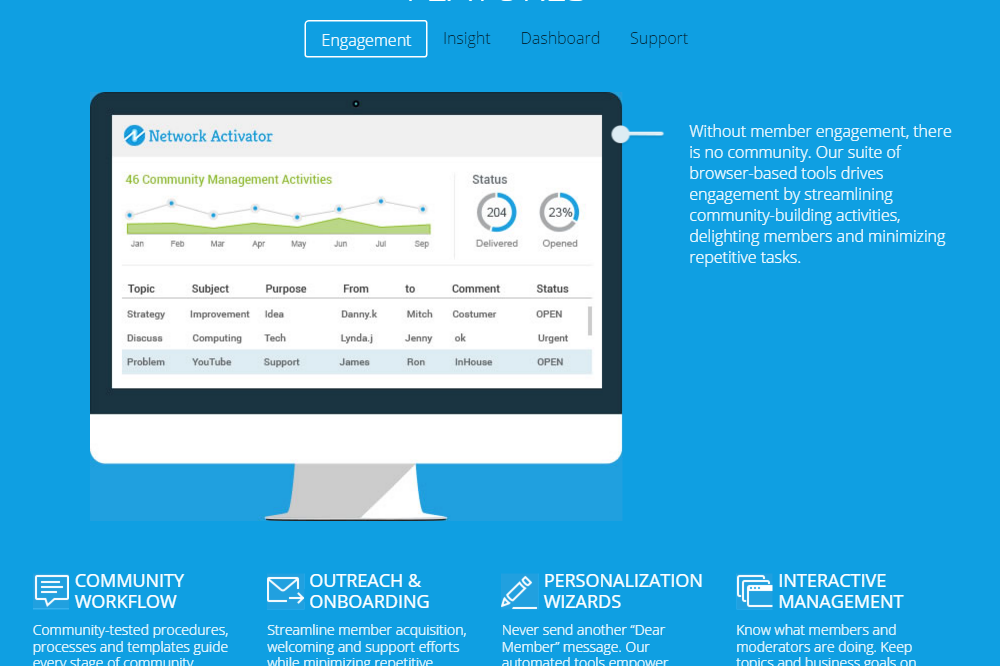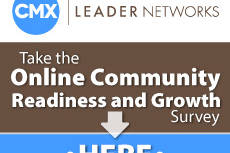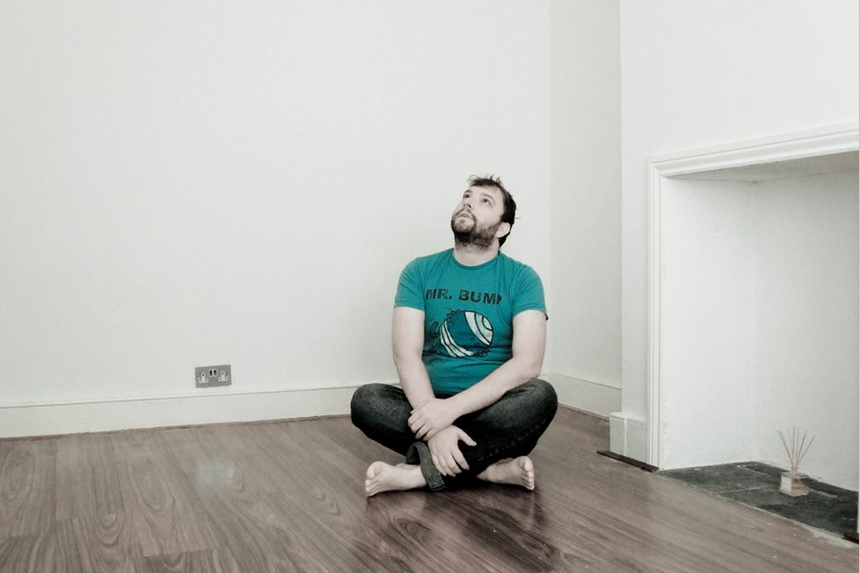 You did it. You built an online community. Time to sit back and let your community members do their thing, right? Wrong. When it comes to member engagement, there’s no rest for the weary.
You did it. You built an online community. Time to sit back and let your community members do their thing, right? Wrong. When it comes to member engagement, there’s no rest for the weary.
That’s because user engagement doesn’t just happen on its own. As a community manager, you’ve got to constantly encourage users to visit, participate, and add their wisdom to the community. The key to making that happen is knowing which stage of activity each user is in—and what prompts are likely to spur him or her to the next stage.
Every member goes through four stages of activity within an online community: being online, doing online, acting online and finally, thinking online. As a user moves through these stages, she deepens her engagement and involvement with the community’s content and with other community members.
Here are some tips to help you move users through the stages of engagement:
Stage 1: being online
Stage 1 users are new or infrequent users who may be hesitant to participate or contribute. They may feel unsure about sharing their knowledge publically or uncertain about what you expect of them. They need training, resources, mentors, and models to follow. To engage members at stage 1 and move them forward, you can:
- Set up regular email communication — Include interesting and ever-changing links back to the community to help drive traffic.
- Highlight site content on your home page ‑Feature new projects, best practices, user Q&A, experiments, support tips, user recognition, polls, a suggestion box, or wish list features.
- Create case study examples — Show users how their peers are gaining value from the community.
Stage 2: doing online
Stage 2 users are occasional users. They may post documents or make comments. They are contributing but you need to encourage them to increase participation and to experiment. To engage members at stage 2 and propel them forward, try these approaches:
- Acknowledge contributions — Identify best individual contributions, welcome newly active users, and set up a basic system of incentives and rewards for contributions.
- Feature users and specific contributions — Using your newsletter and home page, call out user contributions and specific examples of excellence for others to see.
- Encourage user feedback and site suggestions — Make user feedback options available everywhere on the site, then highlight and acknowledge suggestions and feedback (both good and bad) on a regular basis.
Stage 3: acting online
Stage 3 users are regular users who make frequent contributions, set up new projects, offer help and support when asked, and experiment with tools. To drive these folks to the next level:
- Create contests and rewards for “biggest problem solvers” — Shine the spotlight on key problem solvers every day for a week to demonstrate how challenges can get resolved through the peer-to-peer interaction within your community.
- Develop project team case studies — Remember those case studies you shared with stage 1 users? They play an important recognition role with the state 3 users that they feature. Showcasing project teams who have achieved success through the community is a great storytelling opportunity. Be sure to include team members’ photos and contact information in your case studies—recognition is an important motivator!
Stage 4: thinking online
Stage 4 users are your most active and involved leaders. Only a small percentage of your users (8%-10%) will be at this stage. Your goal at this stage is to continue to develop new leaders within the community while promoting the accomplishments of your current leadership group. Here’s how you can do that:
- Recruit and support new leaders — Identify stage 3 users who are doing good things and boost them to stage 4 by making them spokespeople for internal and external communications. Or create an advisory board from this group.
- Let current leaders bestow awards — Create a series of awards within the community, then let your current leadership group nominate and choose award winners. Promote the award choosers and the award winners widely across the community!
The most common mistake that community managers make is not realizing what stage a user is in. If you don’t know a user’s stage, you may approach him too cautiously or too aggressively. For example, why would you ask someone who has just joined the community (a stage 1 user) to upload content immediately or refer their peers? The user is not ready for that level of engagement, and your request could be off-putting.
So what’s the bottom line? The stage matters. Knowing what the stages are— and what’s appropriate at each stage —is the key to ongoing user engagement success.
Warning: Attempt to read property "base" on array in /home3/trusten9/public_html/leadernetworks/wp-content/plugins/wp-user-profile-avatar/shortcodes/wp-user-profile-avatar-shortcodes.php on line 665
Warning: Attempt to read property "base" on array in /home3/trusten9/public_html/leadernetworks/wp-content/plugins/wp-user-profile-avatar/shortcodes/wp-user-profile-avatar-shortcodes.php on line 665
Warning: Attempt to read property "base" on array in /home3/trusten9/public_html/leadernetworks/wp-content/plugins/wp-user-profile-avatar/shortcodes/wp-user-profile-avatar-shortcodes.php on line 665
Warning: Attempt to read property "base" on array in /home3/trusten9/public_html/leadernetworks/wp-content/plugins/wp-user-profile-avatar/shortcodes/wp-user-profile-avatar-shortcodes.php on line 665
Vanessa DiMauro
Internationally recognized independent thought leader on social business strategy and operations with a specialty in online community. I help organizations drive top line growth through innovative digital strategy design and thoughtful execution. I have successfully led 60+ strategic social business initiatives for the world's most influential organizations over my 20 years as a social business executive and serve on a number of boards. My award-winning track-record is fueled by passion, experience and research.
My work has been covered by leading publications such as the New York Times, the Wall Street Journal and CIO Magazine and was recently named a Social Marketing Master by Forbes. As a former Executive in Residence at Babson College, Olin School of Management, I am an engaging and informational educator and keynote speaker.
Related Posts
October 26, 2015
Online Community Managers: A Tool of Our Own!
For years, social media marketers have had tools like Hootsuite, Sprinklr, and…
October 15, 2015
Announcing: Online Community Readiness and Growth Research Study
A new study to find the keys to community readiness and growth
August 31, 2015
The Perils of a Neglected Online Community (Avoiding Failure)
Don't let your customer community be a liability for your brand!
2 Comments
Add comment Cancel reply
This site uses Akismet to reduce spam. Learn how your comment data is processed.



I run a Facebook community of ethnic jewelry collectors and enthusiasts, art dealers, professors, people who manage and buy for famous collections, and authors. The audience is global. As moderator, I curate art, write educational captions, and receive comments. There are two principles: every culture has its genius, and we all engage in the collective quest for accurate information in describing each precious item. Members can also be divided by country.
My key to increasing the level of member involvement is to always surprise people with what country I will highlight each day. People in, or specializing in Central Asia will wait for Central Asian art. People in or specializing in Africa will wait for African art, etc.
I do not pretend to be equal in knowledge to my members, because I am a writer, researcher, and connoisseur. I do not have field experience, such as coming from a family who has sold antique Indian textiles for 3 generations, having the same heritage as the art piece I’m showing, or being a prominent European dealer in African art for 30 years. If information only comes from research, it will produce mistakes because sometimes museums are wrong or are cover up the truth about how they acquired an object.
The members will correct me, and I will admit the mistake, correct the caption and give them credit, publicizing their expertise to the community. When this happens, the involvement level of the member in question will rise. That is the game. Find the mistake in research-only scholarship and correct it with the knowledge only field experience can bring.
There is one level of involvement I would add. Read-only members. They are quite emotionally involved, but prefer to keep their opinions to themselves. Perhaps once a year, they will like a post, which gives me the information that they follow and receive my content. Then I can make contact with them privately. They do not wish to communicate in any other way, but I have to know they are there.
[…] Read more: https://www.leadernetworks.com/2018/07/increase-user-engagement-online-community.html […]